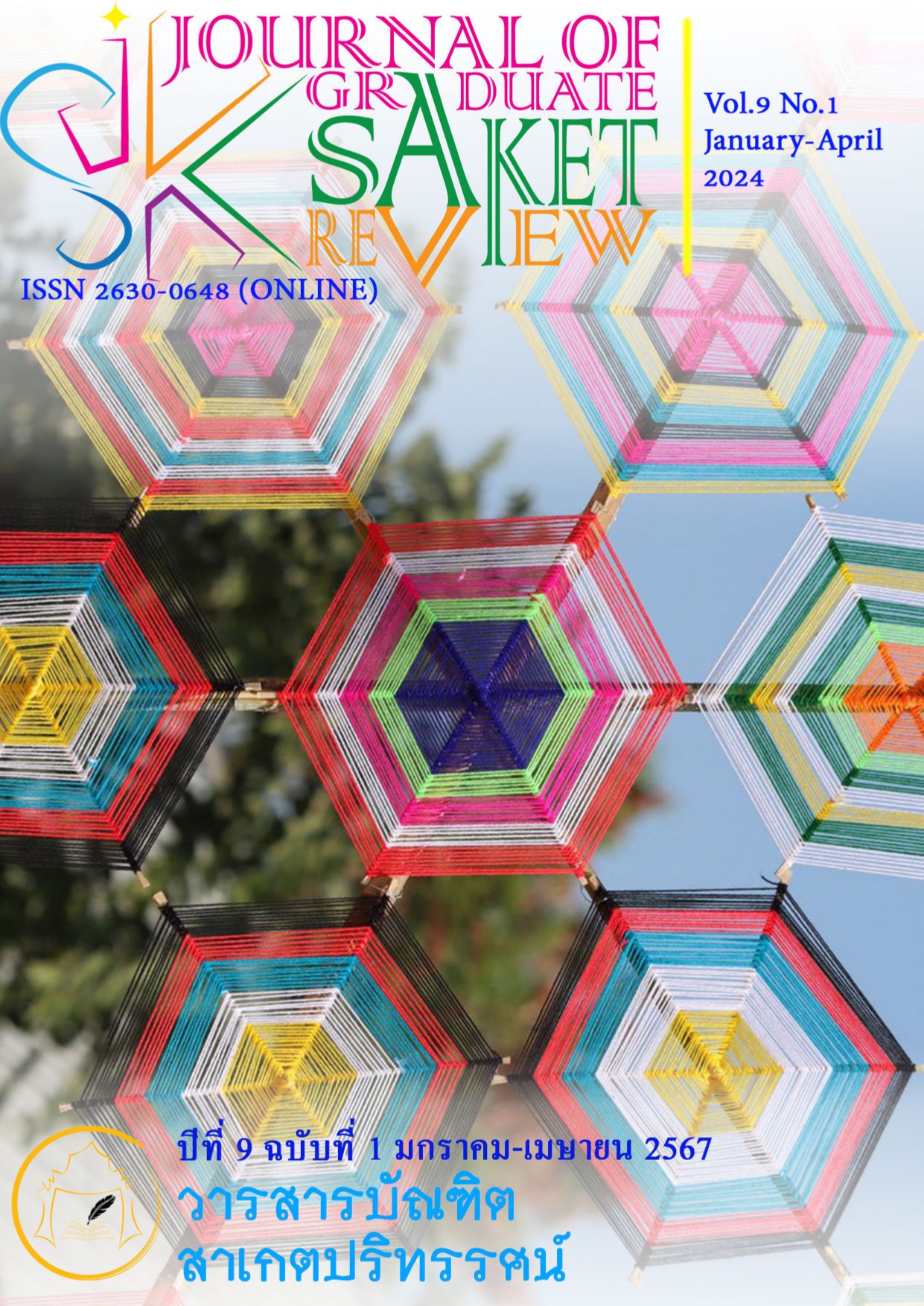การกรวดน้ำ: ความเชื่อและการปฏิบัติที่ถูกต้อง
Main Article Content
บทคัดย่อ
บทความวิชาการนี้มีวัตถุประสงค์เพื่อศึกษาความเชื่อและการปฏิบัติเกี่ยวกับการกรวดน้ำที่ถูกต้อง ผลการศึกษาพบว่า การกรวดน้ำหรือหลั่งทักษิโณทกเกิดขึ้นครั้งแรกในพระพุทธศาสนาสมัยพระเจ้าพิมพิสารอุทิศส่วนบุญให้แก่เปรตญาติของพระองค์ อย่างไรก็ตามสันนิษฐานว่าได้แบบอย่างจากศาสนาพราหมณ์ ซึ่งทำกันอยู่ในสมัยนั้น การถวายน้ำทักษิโณทกมีจุดมุ่งหมาย 3 อย่าง ได้แก่ 1) ถวายเพื่อล้างพระหัตถ์พระพุทธเจ้าหรือฉัน 2) เพื่อเป็นการยืนยันในการบริจาคทาน หรือการมอบถวายสิ่งใดสิ่งหนึ่ง 3) เพื่ออุทิศส่วนบุญให้แก่เปตชน, วิธีกรวดน้ำมี 4 อย่าง ได้แก่ 1) วิธีการกรวดน้ำของพระเจ้าพิมพิสาร 2) การหลั่งอุททิโสทก หรือการหลั่งอุทิโศทก เป็นการมอบกรรมสิทธิแบบเจาะจง 3) การหลั่งปัตถโนทก การให้โดยหลั่งน้ำแบบตั้งความปรารถนา 4) การกรวดแบบ สักขิโณทก คือแบบที่ทำกันอยู่ในปัจจุบัน, การกรวดน้ำในปัจจุบันมีความเชื่อโยงกับเหตุการณ์พระแม่ธรณีได้บีบมวยผมให้น้ำ (ทักษิโณทก) ไหลบ่าท่วมมารและพญามารจนพ่ายแพ้ตอนมาญผจญพระพุทธเจ้าหลังตรัสรู้ใหม่ๆ, การกรวดน้ำในปัจจุบันแตกต่างจากสมัยพุทธกาล คือเป็นการกรวดน้ำลงบนภาชนะ ไม่ใช่การถวายทักษิโณทกหรือหลั่งน้ำบนมือผู้รับ การกรวดน้ำที่มีรูปแบบเฉพาะอย่างหนึ่งคือการกรวดน้ำหรือหลั่งทักษิโณทกตัดความสัมพันธ์กับกรุงหงสาวดีและประกาศอิสรภาพกรุงศรีอยุธยาของสมเด็จพระนเรศวรมหาราช, รูปแบบการกรวดน้ำที่ไม่ถูกต้องคือการใช้มือแตะแขนของผู้กรวดน้ำ, คำกรวดน้ำในบทอิมินาและบทยังกิญจิเป็นการอุทิศส่วนบุญให้แก่เทพ มนุษย์ สัตว์ ตนเอง รวมทั้งตั้งความปรารถนาให้ฝนตกต้องตามฤดูกาลด้วย ซึ่งมีทั้งความเหมือนและแตกต่างจากการกรวดน้ำแบบทั่วไปในปัจจุบัน
Article Details

อนุญาตภายใต้เงื่อนไข Creative Commons Attribution-NonCommercial-NoDerivatives 4.0 International License.
เนื้อหาและข้อมูลในบทความที่ลงตีพิมพ์ในวารสารบัณฑิตสาเกตปริทรรศน์ ถือเป็นข้อคิดเห็นและความรับผิดชอบของผู้เขียนบทความโดยตรงซึ่งกองบรรณาธิการวารสาร ไม่จำเป็นต้องเห็นด้วย หรือร่วมรับผิดชอบใด ๆบทความ ข้อมูล เนื้อหา รูปภาพ ฯลฯ ที่ได้รับการตีพิมพ์ในวารสารบัณฑิตสาเกตปริทรรศน์ ถือเป็นลิขสิทธิ์ของวารสารบัณฑิตสาเกตปริทรรศน์ หากบุคคลหรือหน่วยงานใดต้องการนำทั้งหมดหรือส่วนหนึ่งส่วนใดไปเผยแพร่ต่อหรือเพื่อกระทำการใด ๆ จะต้องได้รับอนุญาตเป็นลายลักอักษรจากวารสารบัณฑิตสาเกตปริทรรศน์ ก่อนเท่านั้น
เอกสารอ้างอิง
ภาษาไทย
ธรรมสภาและสถาบันบรรลือธรรม. (2554). ปฐมสมโพธิกถา. กรุงเทพมหานคร: สำนักพิมพ์ธรรมสภา.
นายอินทร์ เอียด. (2558). การศึกษาวิเคราะห์เรื่องการอุทิศส่วนบุญในประเพณีสารทเขมร (พฺจุมเบ็ญ). ศิลปศาสตรมหาบัณฑิต สาขาวิชาพุทธศาสนศึกษา ภาควิชา
ปรัชญา คณะศิลปศาสตร์ มหาวิทยาลัยธรรมศาสตร์.
พระครูอรุณธรรมรังสี. (ม.ป.ป.). มนต์พิธี. กรุงเทพมหานคร: ม.ป.ท..
พระศรีวิสุทธิญาณ. (2505). ประเพณีกรวดน้ำ. กรุงเทพมหานคร: ม.ป.ท..
พันจันทนุมาศ (เจิม) และจักรพรรดิพงศ์ (จาด). (2507). พระราชพงศาวดารกรุงศรีอยุธยา. พระนคร: คลังวิทยา.
มหามกุฏราชวิทยาลัย. (2556). พระไตรปิฎกสยามรัฐ ภาษาบาลี. พิมพ์ครั้งที่ 7. กรุงเทพมหานคร: มหามกุฏราชวิทยาลัย.
________. (2556). พระไตรปิฎกและอรรถกถาแปล ฉบับมหามกุฏราชวิทยาลัย. พิมพ์ครั้งที่ 8. กรุงเทพมหานคร: มหามกุฏราชวิทยาลัย.
สมเด็จพระพุทธโฆษาจารย์. (2566). พจนานุกรมพุทธศาสน์ ฉบับประมวลศัพท์. พิมพ์ครั้งที่ 62. นครปฐม: วัดญาณเวศกวัน.
สมเด็จพระสังฆราช (ปุสฺสเทว). (2453). สวดมนต์ฉบับหลวง. พระนคร: โรงพิมพ์ ไทย สะพาน ยศเส.
ภาษาอังกฤษ
Dhamma Council and Banluetham Institute. (2011). Pathamasambodhikatha. Bangkok: Thammasabha Publishing House.
Eath I.. (2015). “an analytical study of the doctrine of merit transference in the khmer's pchum ben ceremony”. Master of Arts.
Department of Buddhist Studies Department of Philosophy Faculty of Liberal Arts Thammasat University.
Phrakru Arun Thamrangsi. (M.P.T.). Ceremonial mantra. Bangkok: M.P.T..
Phra Sri Wisutthiyan. (1962). The tradition of pouring water. Bangkok: M.P.T.
Panchanthanumat (Cherm) and Chakraphatphong (Jad). (1964). The Royal Chronicles of Ayutthaya. Phra Nakhon: Khlangwittaya.
Mahamakut Buddhist University. (2013). Tripitaka Siamrath, Pali language. 7th printing. Bangkok: Mahamakut Buddhist University.
________. (2013). Tripitaka and translated Commentary. Mahamakut Buddhist University edition. 8th printing. Bangkok: Mahamakut
Buddhist University.
Somdej Phra Buddhakosajarn. (2023). Dictionary of Buddhism. Glossary edition. 62nd printing. Nakhon Pathom: Wat Yanwetkhawan.
Somdej Phra Sangharaja (Pussadeva). (1910). Royal version of prayers. Phra Nakhon: Thai Printing House, Saphan Yotse.


